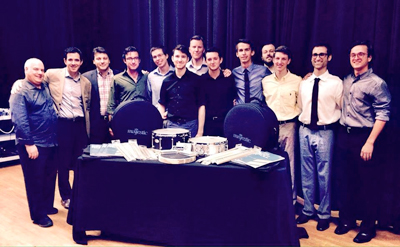by Daniel Hathaway

The five-movement piece forms the third part of the composer’s Makrokosmos, a work that received its premiere at Swarthmore College in 1974 and was last performed in Cleveland in November of 2010 by members of Chamber Music at Lincoln Center on the Cleveland Chamber Music Society series. “I’ve played it a number of times,” Damoulakis said in a telephone conversation. “At Tanglewood in the late ‘90s, then with Manny Ax and his wife on the ‘Great Performances’ series in New York, I think in 2001. I find this piece to be one of the greats. It’s a masterpiece like Beethoven’s ‘Eroica’ Symphony, a piece everyone should hear.”
Music for a Summer Evening requires a large battery of percussion instruments and keeps the players busy moving back and forth among such standard devices as bass drum, xylophone, glockenspiel, suspended cymbals, vibraphone, tam-tam, and triangles, and such exotica as quijada (the jawbone of an ass), African log drum, Tibetan prayer stones, and a jug — to be blown, Appalachian style.
How will Damoulakis and Christian plan their moves? “Crumb does provide a map for sharing instruments in the score, which is in his own handwriting. It’s beautiful, a work of art in itself,” Damoulakis said. “We might have the luxury at CIM of having doubles of certain instruments and not have to share, but it works well both ways because Crumb figured it all out — which is not always the case with other composers.”
And in Crum’s piece, the percussionists do more than strike things to produce sound. “There’s lots of bowing involved as well as singing and vocalizing certain words, and it’s all written into the score,” Damoulakis said. That plus tooting on a recorder and slide whistles.
Bowing techniques are a recent development in the toolkit of percussionists. Patrons of The Cleveland Orchestra recently heard a striking example when Damoulakis and a colleague joined violinist Christian Tetzlaff in high-pitched tones by drawing double-bass bows across crotales (antique cymbals) at the very end of Jörg Widmann’s Violin Concerto. “We had to play the same pitches, or notes a half-step apart,” Damoulakis noted, adding that “bowing isn’t part of the normal training of percussionists, but you hope you’ll get exposed to the techniques along the way — though they seem to be different for each piece.”
Speaking of techniques, Marc Damoulakis just returned from judging the Modern Snare Drum Competition in Atlanta, where he was able to gauge the level of talent on display among the orchestral percussionists of tomorrow. “This is year eight for the competition, and I’ve served on the jury every year but the last one. The committee included two people from the Atlanta Symphony, including Tom Sherwood, who will join the Cleveland percussion section in September. The judging criteria are always a combination of technique, sound, and solo performance aspects.” A recent Eastman graduate took the top prize in the senior division, “and the guy who won the younger division was just incredible,” Damoulakis said.
Damoulakis did see a few red flags pop up during the junior division rounds. “It used to be that all performers would study rudimentary snare drum, drum set, and two-mallet marimba playing. You’d get your touch and sound and style settled, then you’d go to college to specialize. Now I think that some of the training gets specialized too quickly. I see people audition for schools who can play a four-mallet contemporary marimba solo that will blow you away, but then they can’t play a snare drum roll.”
Practice is still the way to get to Carnegie Hall, or at least to Lincoln Center, where Marc Damoulakis will repeat his impressive playing in Messiaen’s Chronochromie during The Cleveland Orchestra’s residency in July. After that, he’ll play the piece in Europe during TCO’s forthcoming tour. “Most people don’t get to do that in their careers, so it’s very exciting for me.”
Published on ClevelandClassical.com June 23, 2015.
Click here for a printable copy of this article






